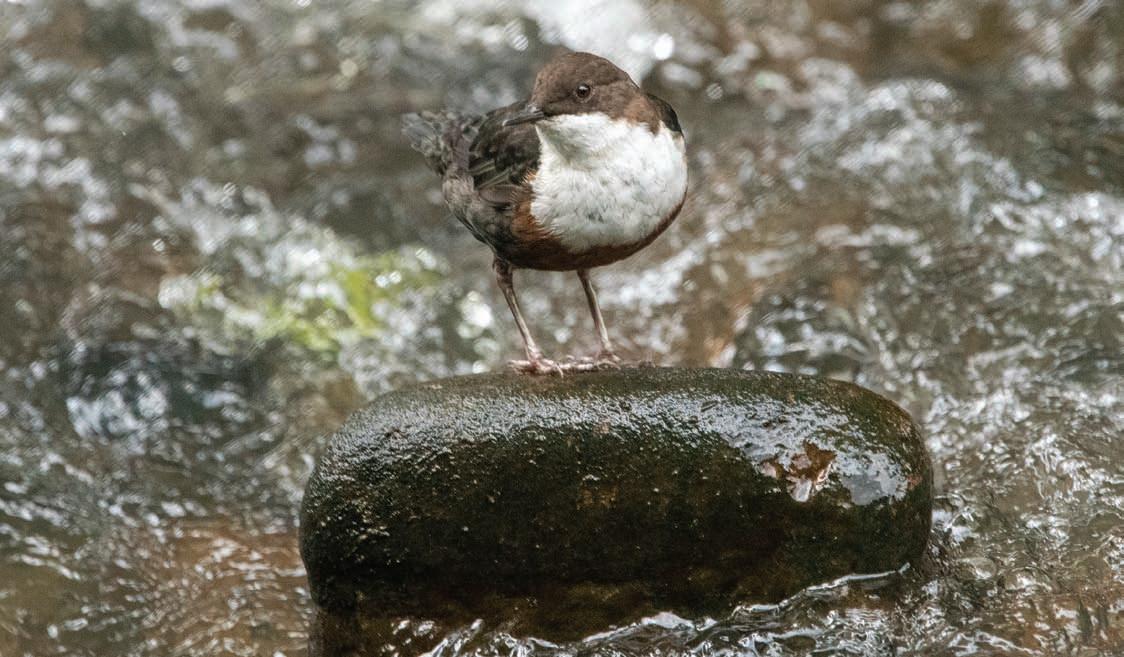
7 minute read
WILD BRISTOL
Dip dip, hooray!
This month, our wildlife columnist, Pete Dommett, goes in search of a swimming songbird
Advertisement
The dumpy dipper has been described as looking like a “wren on steroids”. To catch prey, it stands on a stone mid-stream, jigging up and down on bended knees like a nervous diver, before plunging underwater

Dip (verb): to fail to spot a bird that you really wanted to see. It’s a birdwatching word. And an apt one, because recently I very nearly dipped while searching for a species that I’ve been wanting to see in Bristol for a while – the dipper. If this is a bird that’s unfamiliar, then let me introduce you. In Tweet of the Day (the book version of the popular Radio 4 series), the dipper is described as looking like a “wren on steroids”. It’s a good image: a dumpy bird with a stubby tail, but pumped up to twice the size. At a distance, it appears to be boldly black and white, but, in the same way as if you stared into a pint of stout, a closer look at one of them reveals a more subtle colour scheme of cream, chocolatebrown and chestnut.
Find the dipper in your bird book and it will tell you that it’s a bird of mountain brooks and moorland streams. In the West Country, this means Exmoor and Dartmoor and it’s true that this species thrives alongside water in remote countryside. But, provided there’s a stretch of suitable river on which to feed and breed, dippers can become urban birds.
Records of dippers in Bristol’s Frome Valley go back over 100 years. These birds like fast-flowing rivers (the River Frome takes its name from the Anglo-Saxon word, Frum, meaning rapid): the welloxygenated water supplying them with plenty of aquatic prey. To find it, the dipper stands on a stone mid-stream, jigging up and down on bended knees like a nervous diver, before plunging underwater. Using its short, rounded wings like flippers, the bird propels itself to the riverbed where, by gripping tightly onto pebbles with its feet (having solid, rather than hollow, bones also helps keep it submerged), it walks along the bottom in search of insect larvae, freshwater shrimps and snails. This method of foraging is unique among songbirds and was once widely disbelieved by naturalists.
When it comes to breeding, dippers get going early: by the beginning of this month, they may well have eggs in the nest. This football-sized structure – made of moss, bracken and dry leaves – is squeezed into the stonework of an old bridge or stuffed beneath the overhang of a riverbank or rock face, and often, it would seem, perilously close to the water. No need to worry though – just a few days after fledging, the young birds (can we call them dipperlings?) are able to swim.
I followed the Frome Valley Walkway from Eastville to Frenchay, checking all the likely-looking dipper hotspots. But, after weeks of relentless rain, the river was high and the usual stretches of shallow rapids were completely submerged. So I switched to exploring the smaller streams that feed into the Frome and, just as I was about to call it a day, got lucky – a dipper, perched on a rock in profile, was doing its giant-wren impression. I wanted to see it swim or hear it sing (a sweet, rippling warble, apparently) as I’ve witnessed neither behaviour before, but, as soon as I settled in to watch, the bird took flight and barrelled upstream in a blur of whirring, brown wings. Then, moments after I cursed my fleeting fortune, a second bird followed the first, flying low over the water and calling sharply. So, not one, but a pair of Bristol dippers. Now that’s something to get completely dippy about. ■
SPOTLIGHT ON WOMEN’S HEALTH

As Ovarian Cancer Awareness Month draws to a close, consultant gynaecologist Dr Jo Bailey, from Nuffield Health Bristol Hospital, discusses the symptoms that should never be ignored, and the things you can do to reduce your risk of cancer.
Preventing gynaecological cancers
Cervical screening (smear test) Cervical screening can successfully prevent cancer by checking for HPV (human papillomavirus), which causes the cell changes in the cervix. Many women worry about this, but the virus is so common it can be regarded as the common cold of the cervix. Precancer and cancer of the cervix will become less common, as HPV vaccination has been offered to girls in UK secondary schools since 2008 and boys since September 2019. In the future, smear tests for cervical cancer could be replaced by home sample kits, but we are not at that point yet.
In the UK, all women between the ages of 25 and 64 are offered regular cervical screening. Sadly, half of the women diagnosed with cervical cancer have not had screening in the last 5 years. Uptake of cervical screening has fallen in the last two years for many reasons. Women report that they are unable to secure appointments for smear tests or they are too embarrassed to make an appointment. Women in their 20s and early 30s experienced the biggest fall in screening, which is particularly concerning as 25–29 year-olds have the most cervical abnormalities.

Attendance for screening also declines after the age of 45, despite half of cervical cancer occurring in women over age 49, highlighting the need for women to continue screening after the menopause.
If your screening test detects HPV, you may be offered an appointment for a colposcopy, which is a more detailed examination of your cervix. You may feel nervous about going to colposcopy, especially if you’re not sure what to expect, but there is good information available for patients about screening and colposcopy, to help you feel as comfortable and confident as possible.
Inherited cancers Approximately 5% of endometrial cancers and 20% of ovarian cancers are hereditary. Women with inherited BRCA1 and BRCA2 gene mutations have an increased risk of developing breast and ovarian cancer.
Lynch syndrome confers an increased risk of early-onset cancers, including bowel, endometrial and ovarian.
It is vital to identify high-risk families so that those women can have access to risk reducing interventions, including surgery. You should seek the advice of a geneticist if you have a strong family history of these cancers.
Lifestyle advice There is strong evidence that lifestyle changes can reduce the risk of some cancers. The strongest risk factor for breast and endometrial cancers is being overweight, because as fat mass increases, so do oestrogen levels. Lifestyle changes that focus on achieving and maintaining a healthy weight are key to decreasing the risk of these cancers. Even a 5% weight loss can decrease your risk of developing obesity-related diseases. What symptoms should I look out for? The majority of women with these symptoms will not have cancer, but you should always consult a doctor to have these symptoms investigated.
• Bleeding after the menopause is not normal. The amount doesn’t matter, so if you have any bleeding after the menopause you should see your doctor. • Bleeding after sex. • A new lump, pain, tenderness or bleeding on your vulva. • Symptoms of ovarian cancer can vary from woman to woman. If you have any of these B.E.A.T. symptoms which are new and persistent, tell your doctor.
B is for bloating that doesn’t come and go E is for eating difficulty and feeling full more quickly A is for abdominal and pelvic pain you feel most days T is for toilet changes in urination or bowel habits
It can be difficult to talk about these health worries, but a gynaecologist can put you at ease and talk through your concerns. Nuffield Health offers a complete pathway for your gynaecological needs, including an outpatient treatment room with colposcopy and specially trained staff.
Dr Jo Bailey, consultant gynaecologist and subspecialist in oncology, holds regular clinics at Nuffield Health Bristol Hospital. If you have any concerns regarding women’s health, and would like to book an appointment to see Dr Bailey, call 0117 911 5339, or visit our website: www.nuffieldhealth.com/hospitals/bristol
You can reduce your risk of cancer by doing the following: • Take part in the cervical and breast
screening programmes provided by the NHS • Exercise regularly • Eat a healthy diet • Don’t smoke • Maintain a healthy body weight











